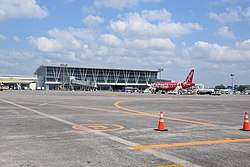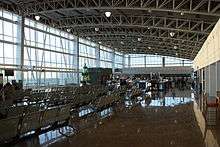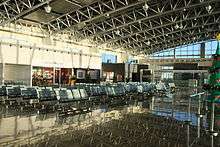Clark International Airport
| Clark International Airport Pangyatung Sulapawan ning Clark Paliparang Pandaigdig ng Clark | |||||||||||
|---|---|---|---|---|---|---|---|---|---|---|---|
.svg.png) | |||||||||||
 Terminal 1 of Clark International Airport | |||||||||||
| Summary | |||||||||||
| Airport type | Public/Military | ||||||||||
| Owner | Bases Conversion and Development Authority[1][2] | ||||||||||
| Operator |
Clark International Airport Corporation Philippine Air Force[3] | ||||||||||
| Serves | Central Luzon and Greater Manila Area | ||||||||||
| Location | Clark Freeport Zone | ||||||||||
| Opened | 16 June 1996[4][5] | ||||||||||
| Hub for | |||||||||||
| Elevation AMSL | 148 m / 484 ft | ||||||||||
| Coordinates | 15°11′09″N 120°33′35″E / 15.18583°N 120.55972°ECoordinates: 15°11′09″N 120°33′35″E / 15.18583°N 120.55972°E | ||||||||||
| Website |
crk | ||||||||||
| Map | |||||||||||
.svg.png) CRK/RPLC Location in the Philippines | |||||||||||
| Runways | |||||||||||
| |||||||||||
| Statistics (2017) | |||||||||||
| |||||||||||
|
Sources from CIAC[6] | |||||||||||
Clark International Airport (IATA: CRK, ICAO: RPLC) (Kapampangan: Pangyatung Sulapawan ning Clark, Filipino: Paliparang Pandaigdig ng Clark), is an airport that is an international gateway to the Philippines within Clark Freeport Zone in Mabalacat City, located 43.2 NM (80.0 km; 49.7 mi)[7] northwest of Manila. The airport is located in the province of Pampanga and is accessible through the Subic–Clark–Tarlac Expressway, which is connected to the North Luzon Expressway.
Clark serves the general vicinity of central and northern Luzon. The name is derived from the former American Clark Air Force Base which was the largest overseas base of the United States Air Force until it was closed in 1991 and handed over to the Government of the Philippines.
The airport is managed and operated by Clark International Airport Corporation (CIAC), a government-owned enterprise; and the southern part of the facility is utilized by the Philippine Air Force as Clark Air Base.[3]
Clark serves both international and domestic flights. A new passenger terminal building is under construction and is expected to be finished in 2020.
History
The United States Cavalry established Fort Stotsenberg in 1902 and later converted a portion of which into an air field, which was, in turn, renamed Clark Air Field in 1919—in honor of aviator Major Harold Melville Clark—and was used as one of the most important overseas bases during the 2nd World War.
In 1947, the RP-US Military Bases Agreement was signed, integrating Clark Air Field and Fort Stotsenberg into Clark Air Base but, after the eruption of Mount Pinatubo in June 1991 and the non-renewal of the military bases agreement, Clark Air Base was reverted to the Philippine Government.
The Bases Conversion Development Act of 1992 accelerated the conversion of Clark Air Base into a Special Economic Zone, and in 2007, the Philippine Congress enacted a law (RA 9400) which renamed the base to Clark Freeport Philippines. It is now segregated in two separate entities: Clark Freeport Zone administered by the Clark Development Corporation, and the Clark Civil Aviation Complex administered by the Clark International Airport Corporation.
In 1993, the former Clark Air Base was reopened as the Clark Special Economic Zone (CSEZ) after the area was cleared from lahar debris from the Mount Pinatubo explosion and a typhoon that followed. During the administration of former President Fidel V. Ramos, it was designated to be the future primary international gateway of the Philippines and the major international airport of Metro Manila and its neighboring provinces when Ninoy Aquino International Airport in Metro Manila has reached full capacity and can no longer be expanded.
CIAC traces its origin from Republic Act No. 7227, otherwise known as the "Bases Conversion and Development Act of 1992", which authorized the conversion of several military reservations, including the former Clark Air Base, into sustainable economic zones. Jurisdiction over the corporation shifted from the Bases Conversion Development Authority (BCDA) and the Clark Development Corporation (CDC) since its formal incorporation with the SEC in 1995.
In 2003, President Gloria Macapagal-Arroyo renamed Clark International Airport as the Diosdado Macapagal International Airport (DMIA), in memory of her father, former President Diosdado Macapagal, and ordered the Clark International Airport Corporation (CIAC) in February 2007 to fund the US$1.7 billion (PH₱76.5 billion) expansion of DMIA and the approval of a US$2 million (PH₱90 million) study plan financed by the Korean International Cooperation Agency. The first stage of Clark Airport's expansion program, a PH₱130 million terminal expansion, was completed in January 2008 to accommodate more than 2 million passengers annually.[8]
In 2011, CIAC became an attached agency of the Department of Transportation and Communications (DOTC) by virtue of Executive Order No. 64 issued by President Benigno Aquino III. With the issuance of EO No. 14 on 28 February 2017 under the administration of President Rodrigo Duterte, CIAC has been reverted as a subsidiary of the BCDA, and has maintained the policy supervision and operational control of the Department of Transportation over the Clark International Airport.
In February 2012 the airport's name reverted to Clark International Airport,[9] but the passenger terminal continued to bear Diosdado Macapagal's name.
In 2014, President Benigno Aquino ordered the restructuring of CIAC from being an attached agency of the Department of Transportation (DOTr) to a BCDA subsidiary by virtue of Executive Order 14.
Geographical location
Clark International Airport is in Luzon Island, approximately 98 kilometers from Manila in the south, 163 kilometers from Baguio City in the north, and a substantial portion of which is surrounded by Angeles City in the province of Pampanga. The airport lies in between the Mount Pinatubo on the West and the Mount Arayat on the East.
The airport site is inside the Clark Freeport Zone’s Civil Aviation Complex which occupies 2,367 hectares and directly linked to the Subic-Clark-Tarlac Expressway (SCTEX) which is connected to the North Luzon Expressway (NLEX) providing a direct link to Metro Manila.
CRK has a local catchment area with an estimated population of 23 million covering Regions 1, 2 and 3, Cordillera Administrative Region, and the northern part of the National Capital Region (Quezon City and CAMANAVA area).
Terminal Complex
Existing Passenger Terminal Building


The original terminal was expanded for $3 million (PH₱130 million) to accommodate 1 million passengers annually. The expansion project was inaugurated by President Arroyo on April 2008 to serve the growing passenger volume due to the entry of foreign and local budget carriers at the airport.
Phase I expansion started in April 2010 for $12 million (PH₱550 million) that saw a second story, arrival and departure lounges, and two aerobridges added to the terminal building. The expansion boosted Clark's capacity to 2.5 million annually.
In 2013, Phase II expansion which costs $9.6 million (PH₱417 million) increased the capacity of the passenger terminal from 2.5 million to 4.2 million passengers per annum. The expansion increased the size of the passenger terminal building from 11,439m² to 19,799m². It added 21 new check-in counters, increasing the total number of counters from 13 to 34. Five arrival counters and 12 departures counters were also constructed. The expanded terminal currently has eight entry points and three customs stations. The modernized terminal started operations in May 2013.[10]
New Passenger Terminal Building
The PH₱12.55 billion project involves the construction of a new 82,600m² passenger terminal building with a design capacity of 8 million passengers per annum, bringing the total capacity of Clark to 12.2 million passengers annually. The new passenger terminal building is expected to be finished by 2020.
Future Development
Two more terminals are expected to be completed and all will be fully operational by 2025. Upon completion, these four terminals will boost Clark’s passenger capacity to more than 110 million annually. The airport is also being groomed to become one of the country’s first "aerotropolis" or a community that features a world-class airport and surrounded by business clusters and residential developments.[11]
Runways
Clark Airport used to have two 3,200-meter parallel runways. Since the runways are closely spaced, the secondary runway (02L/20R) has been decommissioned and is no longer in use. A new maintenance hangar is currently being constructed on the stopway of Runway 02L.[12]
- The primary runway (Runway 02R/20L) has a length of 3,200 meters and a width of 60 meters. It is equipped with various navigational aids and lighting facilities, and it has a Category 1 rating for precision approach.
Airlines and destinations
CRK currently hosts 490 flights per week (332 Domestic flights, 158 International flights). As of June 2018, the airport services 19 local destinations, 9 international destinations.
Passenger
Cargo
Statistics
Data from Clark International Airport Corporation (CIAC).[6]
Passenger movements
| Year | Domestic | International | Total | Change |
|---|---|---|---|---|
| 2013 | 215,173 | 985,419 | 1,200,592 | |
| 2014 | 90,948 | 786,809 | 877,757 | |
| 2015 | 41,824 | 826,704 | 868,528 | |
| 2016 | 51,625 | 899,382 | 951,007 | |
| 2017 | 431,343 | 1,083,188 | 1,514,531 |
Aircraft movements
| Year | Domestic | International | Total | Change |
|---|---|---|---|---|
| 2013 | 1,916 | 8,420 | 10,336 | |
| 2014 | 936 | 5,715 | 6,651 | |
| 2015 | 348 | 5,709 | 6,057 | |
| 2016 | 360 | 5,852 | 6,212 | |
| 2017 | 5,399 | 7,221 | 12,620 |
Awards
Ground transportation
Motor vehicle
The Subic-Clark-Tarlac Expressway (SCTEx) provides access through the airport, with two exits: Clark North and Clark South interchange, where the latter leads directly to Clark. Passengers with connecting flights at Ninoy Aquino International Airport in Metro Manila can take North Luzon Expressway which is linked via SCTEx, then passing through Epifanio de los Santos Avenue, Roxas Boulevard and finally onto NAIA Road. The future corridor between NAIA and Clark International Airport is the Metro Manila Skyway Stage 3 from NLEx to SLEx and NAIA Expressway from Skyway and SLEx to NAIA Terminals. The target completion of the NLEx-SLEx elevated expressway link project is 2019.
Park and fly services are provided within the airport as well.[27]
Public transportation
Regular bus services going directly to Metro Manila are served by Partas and Philtranco; although not operating after midnight hours. On 15 January 2013, an additional stop was opened in TriNoma Mall that will operates 24 hours a day and will be initially offered by Genesis, Five Star, and Philtranco.[28]
Clark is also served by airconditioned jeepneys en route to nearby Dau bus terminal and SM City Clark. Most buses running to the northern provinces of Luzon and back to Metro Manila include a stopover at Dau bus terminal.
Incidents
See also
References
- ↑ "BCDA to build Clark International Airport under DOTC Leadership" (Press release). Bases Conversion and Development Authority. 24 October 2011. Retrieved 30 December 2012.
BCDA wrote Sec. Mar Roxas to map out its plans and strategies for major infrastructures under BCDA’s ownership and mandate such as the Clark International Airport.
- ↑ Amojelar, Darwin G. (22 October 2011). "BCDA to build Clark International Airport". The Manila Times. Retrieved 30 December 2012.
Casanova emphasized that the BCDA owns the properties and assets of the Clark International Airport Corp. (CIAC) and Clark Development Corp. (CDC) which gives it legal authority to undertake the development of the airport.
- 1 2 "Clark Air Base". Philippine Air Force. Retrieved 31 December 2012.
Though the air facility principally handled civilian air traffic (it was planned to replace Ninoy Aquino International Airport as Metro Manila's primary airport), the Philippine Air Force maintained a presence there, and part of it was still known as Clark Air Base.
- ↑ "2007 Annual Report" (PDF). Clark International Airport Official Website. Clark International Airport Corporation. p. 16. Retrieved 17 June 2016.
- ↑ "Remembering CRK's 1st flight 20 years ago, June 16, 1996". Facebook. Clark International Airport Corporation. Retrieved 17 June 2016.
- 1 2 "Vital Information" (PDF). Clark International Airport Corporation. Retrieved 8 June 2016.
- ↑ Baluyut, Joelyn (10 October 2012). "NAIA flights diverted to Clark". Philippine Information Agency. Retrieved 13 January 2013.
- ↑ Sunstar.com Archived 28 September 2008 at the Wayback Machine.
- ↑ "Clark airport name-change plan sparks debate". ABS-CBN News. 2012-02-28. Retrieved 2013-08-24.
- ↑ http://www.airport-technology.com/projects/clark-international-airport-cia-expansion-pampanga/
- ↑ "Central Luzon: The newest emerging business destination". SunStar. 4 February 2018. Retrieved 6 September 2018.
- ↑ Public-Private Partnership Center (PDF) https://ppp.gov.ph/wp-content/uploads/2018/05/BCDA_PROJ_Clark-Airport-InfoMemo_20180507.pdf. Retrieved 29 September 2018. Missing or empty
|title=(help) - 1 2 https://www.cebupacificair.com/pages/seat-sale-promo
- ↑ https://www.routesonline.com/news/38/airlineroute/278068/cebu-pacific-cebgo-domestic-network-changes-in-s18/
- ↑ http://ph.ceair.com/newwebsite/ph/kelake/index.html
- ↑ https://www.philippineairlines.com/en/~/media/files/flighttimetable/domestic%20summer%20%20winter%20september%2028%202018.pdf?la=en/
- ↑ https://www.philippineairlines.com/en/~/media/files/flighttimetable/domestic%20summer%20%20winter%20september%2028%202018.pdf?la=en/
- ↑ https://www.philippineairlines.com/en/about%20us/newsandevents/boracay-closure
- 1 2 https://www.philippineairlines.com/en/~/media/files/flighttimetable/domestic%20summer%20%20winter%20june%2019%202018.pdf?la=en
- ↑ https://www.philippineairlines.com/TravelInformation/FlightTimetable?scController=FlightTimetable&scAction=FlightTimetable&origin=CRK&originCountry=PHILIPPINES&originCity=CRK&destination=SWL&destination=PHILIPPINES&destination=SWL
- ↑ https://booking.airasia.com/Flight/Select?o1=CRK&d1=CGY&culture=en-GB&dd1=2018-10-28&dd2=2018-10-28&r=true&ADT=1&s=true&mon=true&cc=PHP&c=false
- ↑ https://support.airasia.com/s/article/What-are-the-Service-Recovery-options-due-to-Boracay-island-closure?language=en_GB
- 1 2 3 4 5 6 http://crk.clarkairport.com/downloads/flight-schedule/flight-schedule.pdf
- ↑ "DMIA bags Low-Cost Airport Award".
- ↑ "DMIA awarded 'Airport of the Year' by global consulting group".
- ↑ "Routes Asia 2013 :: Routes Airport Marketing Awards". Routesonline. Retrieved 2013-08-24.
- ↑ "Frequently Asked Questions". Clark International Airport Corporation. Retrieved 13 January 2013.
- ↑ Pavia, Joey (13 January 2013). "CIA eyes 2M passengers in 2013, launches Clark-TriNoma bus route". The Business Mirror. Retrieved 13 January 2013.
- ↑ "Korean caught with shabu, gun at Clark Airport". Inquirer. Retrieved 25 September 2018.
External links
| Wikimedia Commons has media related to Clark International Airport. |
- Official website
- Current weather for RPLC at NOAA/NWS
- Accident history for CRK at Aviation Safety Network
- Clark International Airport Corporation